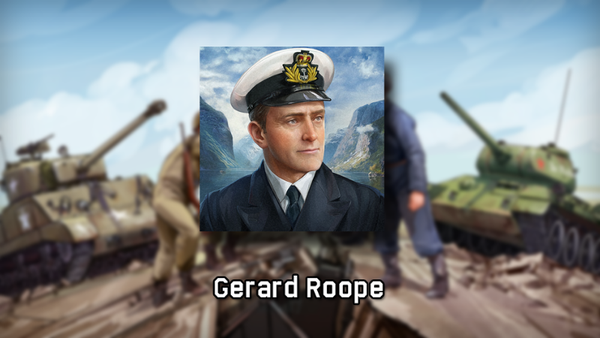For the whole month, you will have 8 tasks available to you one by one.

Completion of each task will award you with a trophy containing a reward, while completing all tasks will award you with a unique in-game player icon.
A detailed description of the current task as well as your overall progress can be found by clicking on your nickname → Achievements → Pages of HistoryReward for completing all 8 tasksGerard RoopeDuring World War II Gerard Roope, commander of HMS Glowworm, was the first to perform a heroic deed deserving of a Victoria Cross, the highest military award of the British forces.
On April 8th, 1940, near the coast of Norway Glowworm found itself outgunned against the German heavy cruiser Admiral Hipper.
Heavily damaged Glowworm rammed the enemy ship, piercing her hull, and fired a last shot before capsizing. Gerard Roope perished helping the crew escape the sinking ship.
Hellmuth Heye, commander of the Admiral Hipper, was so impressed by Roope's actions that he wrote a letter to the British authorities recommending him for an award.
You can immediately purchase the profile icon for Golden Eagles until May 3rd, 11:30 GMT without completing tasks. Click Nickname → Achievements → Pages of History (April).
Trophy reward for each taskCompletion of each individual task will bring you a trophy with one of the following rewards: 20-50% RP booster for 3-10 battles; 20-50% SL booster for 3-10 battles; 3-5 universal backup vehicles; 1 day of premium account; A random camouflage for ground vehicles (out of the selection of camouflages currently obtainable in game for completing tasks, or purchasing with Golden Eagles).
Other terms Tasks are available from 11:00 GMT until 11:30 GMT on the final day of each task. Tasks can be completed in random battles, except for “Assault” mode.
April 1st — April 4thOperation
IcebergOn April 1st, 1945 an operation to capture the island of Okinawa by US forces began.
The battle lasted for almost three months and took the lives of over 200, 000 Japanese soldiers and Okinawa’s citizens.
Controlling Okinawa gave the US a military base and airfields that could be used for the potential full scale invasion of the main territory of Japan.
April 5th — April 8thBattle of KönigsbergKönigsberg, the key German stronghold in East Prussia, was stormed by Soviet forces from April 6th through to the th9, 1945.
The Red Army was well-prepared: the soldiers learned the tactics of urban combat beforehand, and to prepare for the assault, German defenses were attacked by artillery and aircraft.
As a result, the USSR suffered far fewer losses than the Third Reich, and the operation was completed swiftly and effectively.
April 9th — April 12thOperation WeserübungOn April 9th, 1940, Germany began operation Weserübung (Weser Exercise) to quickly gain control over Denmark and Norway.
Denmark didn’t put up much of a resistance, and its capture took only six hours, making it the shortest military operation of WWII.
Norway resisted with the help of Poland, France, and Great Britain, but on May 10th the Battle of France began, and the support of Norway quickly dried up.
On June 10th the Norwegian government fled to London, and the country fell under German control.
April 13th — April 16thGraz-Amstetten OperationAfter capturing Vienna, the Soviet Army continued to rout the Wehrmacht across Austria and northern Yugoslavia.
Graz-Amstetten offensive operation was the last one in this region: it began on April 15th, 1945, by countering a strong counteroffensive by the German forces that lasted for two weeks, and continued until the end of the war on May 9th, with some garrisons and units fighting even after the surrender of Germany.
April 17th — April 20thBattle for HamburgBy mid April of 1945 Hamburg remained the last stronghold of the Wehrmacht’s resistance in northern Germany.
On April 18th British forces started advancing towards the city, entering Hamburg proper near the end of the month, when Germany was already negotiating its surrender.
The city’s capture was relatively bloodless, but by that time Hamburg was already devastated by bombings. April 20th —
April 23rdOperation VulcanOn April 22nd, 1943 the Allies began operation Vulcan aiming to crush the last Axis defenses in northern Tunisia.
The battle proved difficult due to Axis forces being well-prepared, with German paratroopers performing an unexpected counterattack.
Still, in two weeks, by May 7th, Allies captured Tunis, and the victory was at hand.
April 24th — April 27thElbe DayOn April 25th, 1945, two allied armies, from east and west, met on the banks of Elbe.
First two American patrols that crossed the river greeted the Soviet soldiers, and on the next day two lieutenants, William Robertson and Alexander Silvashko, took the famous “East Meets West” photo in Torgau.
April 27th— April 30thCambodian invasionA coup d’etat happened in Cambodia in 1970.
General Lon Nol after coming to power demanded Viet Cong to leave his county, but instead they, along with Khmer Rouge, the local resistance group, took up arms against the Cambodian army.
On April 29th, 1970, the US forces entered Cambodia to support Lon Nol.
The operation lasted for three months and was tactically successful: North Vietnamese forces took heavy losses and had to postpone their invasion of South Vietnam.
Still, war in Cambodia led to growing support for the Khmer Rouge, who took over the country in a few years.



















0 Comments:
Leave a Reply